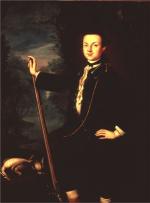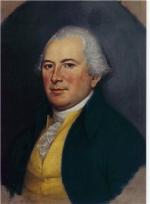![header=[Marker Text] body=[Member of the Continental Congress, a Revolutionary soldier, first Pennsylvania governor, 1790-1799, lived at his estate Angelica from 1774 to 1794. The Berks County Farm and Home now occupies the site.] sign](kora/files/1/10/1-A-159-139-ExplorePAHistory-a0a8n4-a_450.gif)
Mouse over for marker text
Name:
Thomas Mifflin
Region:
Hershey/Gettysburg/Dutch Country Region
County:
Berks
Marker Location:
US 222 (E. Lancaster Ave.) At Mifflin Blvd., Shillington
Dedication Date:
March 27, 1947
Behind the Marker
The men who joined together in the rebellion against British rule were a varied and contentious lot, who had deep disagreements about the best form of government for Pennsylvania and the new nation. Prominent among the moderate patriots was Thomas Mifflin, whose political career shows how difficult it was to be a moderate in Pennsylvania's complex and tumultuous political world.
Unlike many other patriots, Mifflin was born into the established provincial elite. His father was a wealthy Quaker merchant from a family that had been in Pennsylvania for several generations. Educated at the College of Philadelphia, Mifflin completed a merchant apprenticeship and then formed a business partnership with his brother.
Early in the imperial crisis, Mifflin took a radical position and was criticized by Philadelphia's Quakers for participating in the city's extra-legal committees. As a member of the provincial assembly, he was selected to represent Pennsylvania at the First Continental Congress in 1774. When fighting broke out in Massachusetts the following year, Mifflin became an aide to Gen. George Washington, and then disowned by the Society of Friends for taking up arms.
Between 1775 and 1778, he served as Quartermaster General of the Continental Army and was accused of conspiring with other officers and members of Congress to replace Washington with General Horatio Gates as commander of the Continental Army. This bitter internal controversy within the Revolutionary establishment - often called the "Conway Cabal" - marred Mifflin's reputation. Also during this same period, he served on the Board of War, an independent agency created by Congress in 1777 to execute legislative policies.
General Horatio Gates as commander of the Continental Army. This bitter internal controversy within the Revolutionary establishment - often called the "Conway Cabal" - marred Mifflin's reputation. Also during this same period, he served on the Board of War, an independent agency created by Congress in 1777 to execute legislative policies.
After 1778 Mifflin resigned from the military and devoted himself to elective politics. As a member of the Continental Congress from 1782 to 1784, he was a moderate who tried to mediate in the growing conflict between conservatives like James Wilson and
James Wilson and  John Dickinson, and the Constitutionalists who supported Pennsylvania's radical state government. When the call was made for a new federal convention in 1787, Mifflin represented Pennsylvania and worked hard for the ratification of the new constitution.
John Dickinson, and the Constitutionalists who supported Pennsylvania's radical state government. When the call was made for a new federal convention in 1787, Mifflin represented Pennsylvania and worked hard for the ratification of the new constitution.
Like many of Pennsylvania's revolutionary political elite, he was critical of the democratic features of the state's radical 1776 constitution. Accordingly, Mifflin helped to organize the "Republican Society," a political group dedicated to replacing the 1776 constitution with a more conservative instrument of government, and then presided over the state's 1790 constitutional convention that accomplished that objective.
Having guided Pennsylvania through the fledgling years of nationhood, Mifflin was seen as a natural candidate for governor, an office whose creation was one of the new constitution's signature accomplishments. He governed Pennsylvania from 1790 to 1799, still trying to hold a middle ground between the warring political forces that created the United States' first "party system."
One of his most notable actions as governor was to oversee the negotiations with Indian tribes and the federal government that incorporated the "Erie Triangle," into the state. The subsequent removal of the state's last independent Indian tribes gave Pennsylvania direct geographical access to the Great Lakes.
Unlike many other patriots, Mifflin was born into the established provincial elite. His father was a wealthy Quaker merchant from a family that had been in Pennsylvania for several generations. Educated at the College of Philadelphia, Mifflin completed a merchant apprenticeship and then formed a business partnership with his brother.
Early in the imperial crisis, Mifflin took a radical position and was criticized by Philadelphia's Quakers for participating in the city's extra-legal committees. As a member of the provincial assembly, he was selected to represent Pennsylvania at the First Continental Congress in 1774. When fighting broke out in Massachusetts the following year, Mifflin became an aide to Gen. George Washington, and then disowned by the Society of Friends for taking up arms.
Between 1775 and 1778, he served as Quartermaster General of the Continental Army and was accused of conspiring with other officers and members of Congress to replace Washington with
After 1778 Mifflin resigned from the military and devoted himself to elective politics. As a member of the Continental Congress from 1782 to 1784, he was a moderate who tried to mediate in the growing conflict between conservatives like
Like many of Pennsylvania's revolutionary political elite, he was critical of the democratic features of the state's radical 1776 constitution. Accordingly, Mifflin helped to organize the "Republican Society," a political group dedicated to replacing the 1776 constitution with a more conservative instrument of government, and then presided over the state's 1790 constitutional convention that accomplished that objective.
Having guided Pennsylvania through the fledgling years of nationhood, Mifflin was seen as a natural candidate for governor, an office whose creation was one of the new constitution's signature accomplishments. He governed Pennsylvania from 1790 to 1799, still trying to hold a middle ground between the warring political forces that created the United States' first "party system."
One of his most notable actions as governor was to oversee the negotiations with Indian tribes and the federal government that incorporated the "Erie Triangle," into the state. The subsequent removal of the state's last independent Indian tribes gave Pennsylvania direct geographical access to the Great Lakes.
Beyond the Marker







